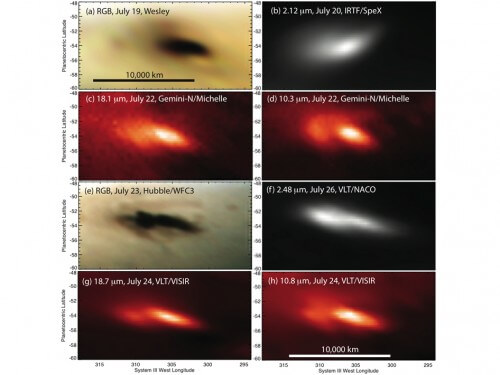In the twenty years that have passed since the well-publicized and large impact of comet Shoemaker-Levy 9 in Jupiter in 1994, four more impacts have been observed

Haim Mazar
since The impact of Comet Shoemaker-Levy 9 on the planet Jupiter In 1994, 4 more injuries were observed. The first was on 21.7.2009 and it occurred near the South Pole, which resulted in the warming of the upper atmosphere at the site of the impact and the flight of particles and probably also of ammonia upwards (1). The impact created a blob the size of the Pacific Ocean. The impact site is 305 degrees West 57 degrees South (2). The information accumulated by 3 infrared telescopes and the Hubble telescope led to the conclusion that it is a rocky asteroid and not a comet. The warming of the lower stratosphere was at a rate of 4-3 degrees 42 km above the top of the clouds.
As a result of the impact, ammonia and other gases were blown up and then returned to the atmosphere. The impact of Comet Shoemaker/Levy, on the other hand, did not heat the upper atmosphere. Based on the fact that the density of the impacting body in 2009 was 2.5 g/cm200, they came to the conclusion that it was an asteroid with a diameter between 50-3 meters (3.6.2010). Two more impacts were on 20.8.2010/10/13 and 4/10.12.2012/1.5. The size of these bodies is estimated between 2 and 5 meters. (XNUMX). A fourth impact was on XNUMX. The impact flash was between XNUMX and XNUMX seconds (XNUMX).
These impacts and rock fragments on the Martian soil in recent years that have been seen by the all-terrain vehicles operating there clearly show that such impacts are not a thing of the past, but they continue even in our time. It is enough for two asteroids to collide and their fragments will fly everywhere to the point of hitting the planets. This phenomenon raises the thought of launching a telescope and putting it into orbit around the Sun in the space between Jupiter and Saturn. In some of his observations he will monitor impacts on the gaseous planets. It will be possible to learn about their atmospheres.
Sources
1. 'New NASA images indicate object hits Jupiter"21.7.2009
2 "Jupiter pummeled leaving a bruise the size of the Pacific Ocean"22.7.2009
3. 'Asteroid ahoy: Jupiter scar likely from rocky body” 27.1.2011
4. 'Impact 'fireballs' spotted on Jupiter"9.9.2010
5. Tariq Malik – “Explosion on Jupiter spotted by amateur observations” 11.9.2012
